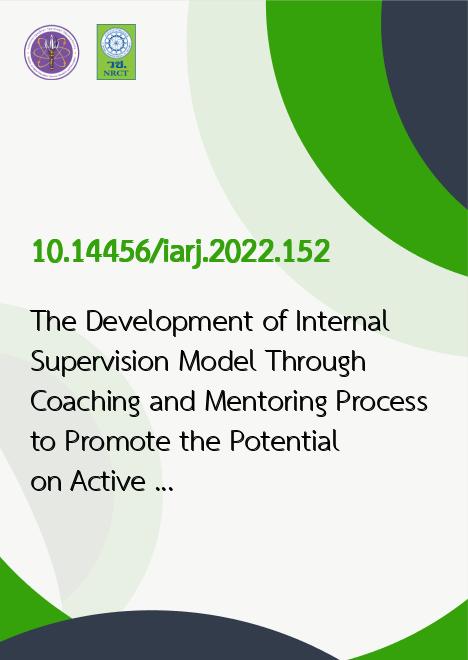
|
The Development of Internal Supervision Model Through Coaching and Mentoring Process to Promote the Potential on Active Learning |
|---|---|
| รหัสดีโอไอ | |
| Creator | Suchat Wangsothorn |
| Title | The Development of Internal Supervision Model Through Coaching and Mentoring Process to Promote the Potential on Active Learning |
| Publisher | DR.KEN Institute of Academic Development and Promotion |
| Publication Year | 2565 |
| Journal Title | Interdisciplinary Academic and Research Journal |
| Journal Vol. | 2 |
| Journal No. | 6 |
| Page no. | 363-384 |
| Keyword | Internal Supervision, Coaching and Mentoring Process, Active learning |
| URL Website | https://so03.tci-thaijo.org/index.php/IARJ/about |
| Website title | https://so03.tci-thaijo.org/index.php/IARJ/article/view/264711 |
| ISSN | 2774-0374 |
| Abstract | Educational supervision, which is a system to support quality education in schools, has therefore analyzed and designed internal supervision operations to develop teaching and learning management along with developing students through a joint lesson development process in active learning activities. The purposes of this research were 1) to study the need assessment in developing an internal supervision model through Coaching and Mentoring process to promote the potential on active learning management; 2) to develop an internal supervision model using Coaching and Mentoring process; 3) to try and study of the result an internal supervision model using Coaching and Mentoring process and 4) to evaluate and improve an internal supervision using Coaching and Mentoring process. There were 4 steps in research and development (R&D) which were 1) studying the need assessment in developing an internal supervision model through Coaching and Mentoring process to promote the potential on active learning management; 2) improving an internal supervision model through Coaching and Mentoring process; 3) demonstrating an internal supervision model using Coaching and Mentoring process and 4) evaluating an internal supervision model using Coaching and Mentoring process. The sample consisted of 12 administrators, supervisory team, and 73 supervised teachers which were obtained by simple random sampling. The tools used in this research were an analysis record of concepts, theories, and related researches, focus group issues, a questionnaire for supervisory team and supervisory recipient’s basic information, a check list for accordance of the supervision model, pre-test and post-test, interview form for active learning management skill and the supervision model, an evaluation form for learning plans, a teaching observation form, a record of Coaching and Mentoring process results, a record of being supervised, an observation form for supervisory team, an observation form for the supervised, and an evaluation form for the supervision model. Qualitative data were analyzed by content analysis and description. The quantitative data were analyzed using statistics which were percentage, mean and standard deviation. The finding found that (1) Studying the needs and requirements in developing the internal supervision model by using the guidance process and the mentoring system consisting of 3 aspects: (a) Proactive learning management education. (b) Supervision education using a guidance process and a mentoring system. And (c) supervision, monitoring and evaluation by using an internal supervision system that has a supervision model suitable for the school context. (2) develop an internal supervision model using a guidance process and mentoring system to promote proactive learning management potential, Its main components are principles and essential terms which has a 5-step process, namely (A) T : Team, (B) H : Holistic Planning, (C) U : Use, (D) N : Nice Coaching and Mentoring, and (E) K : Knowledge Management. (3) The results of the experimental use of the internal supervision model using the guidance process and the mentor system to enhance the potential of proactive learning management revealed that the average score of the supervision team after the training was higher than before the training which the mean score before the training was 14.47 points, and the score after the training was 16.53 points. The score difference increased by 10.34% and the average score of the supervision recipients after the training was higher than before the training as well, which the mean score before the training was 10.40 points, and the post-training score was 11.87, the difference in the score increased. 5.67 percent. However, based on these scores, the workshop tends to help develop the supervision team and the supervision recipients with more knowledge of proactive learning techniques, and supervision using guidance and mentoring processes. (4) The results of evaluation and improvement of the internal supervision model by using the guidance and mentoring process before applying the model in terms of usefulness, feasibility, suitability, and overall correctness were at the highest level. And the results of assessing the appropriateness of the internal supervision model manual by using the THUNG Model to develop proactive learning management. |